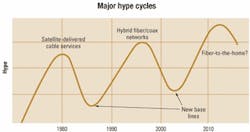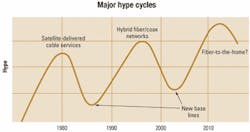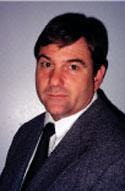Looking to the next 'hype cycle'
The 'hype cycle' theory can help predict when FTTH will become part of the mainstream.
BY MITCH SHAPIRO AND DON GALL
What is a "hype cycle" you ask? According to Dave Pangrac, president and founder of Pangrac & Associates Consulting, it is a great way to track how an industry adopts technology in a rapidly changing environment. It also provides insight into how an industry will react to new technology.
A key factor in the hype cycle is the expectations of Wall Street. Like most technology-based industries, cable television involves very heavy up-front capital investment. Installing and/or changing a network costs millions of dollars-billions for the major players. To finance this kind of investment, the financial community must be convinced they will get a return on their investment. "Hype" is the excitement and activity buildup around the new idea/technology that generates interest within the investment community and general public, pushing it over the edge into the sink-or-swim environment of modern business. In this context, hype is not a derogatory term, but rather a necessary ingredient in this process of mobilizing support for large-scale technology investment.
Downturns and troughs
Competitive dynamics also impact the hype cycle. As we all know, competitors-which have hype cycles of their own-work hard to erode incumbents' market share. The entry of satellites into the multichannel video market is a good example. The impact of digital broadcast satellite (DBS) on cable-subscriber growth demonstrates how competitive pressures contribute to the troughs that persist until the next hype cycle starts. Such downturns provide a feedback mechanism that tells an industry the growth potential of its once-new technologies is waning. Typically, this negative feedback shows up on the bottom line, which in turn is reflected in stock prices and the ability to secure new capital.
Some technologies have the power to move an entire industry to the next level. When HBO became available via satellite in the mid-1970s (the first of many networks), cable TV exploded from mostly small mom-and-pop enterprises to large businesses serving major metropolitan areas. This single innovation drove Wall Street into an investment frenzy, which in turn stimulated vendors to create all sorts of equipment to facilitate the resulting growth. This cycle lasted about 10 years. The cable industry subsequently fell out of favor with Wall Street, as its growth fell short of the lofty expectations set during an earlier phase of the hype cycle.
Cable's second major hype cycle centered on hybrid fiber/coax (HFC) cable, which took off in the early '90s, when the cable industry was in a slump. All of the major cities in the United States had been built using the older all-coaxial network architecture that was ill-suited for large major markets. The addition of singlemode fiber enhanced reliability, while also making it feasible for cable networks to deliver high-speed data and telephone services. The industry then spent billions of dollars upgrading networks to the new HFC architecture, which in turn has had major impacts on cable industry economics. Investors are now looking to reap the benefits promised during HFC's upswing, while competitors (e.g., DSL, DBS) have made countermoves aimed at eroding cable's share of the affected market segments.
There are also smaller cycles that rise and fall around the major cycles-broadband data, telephone over cable, and local advertising insertion, to name a few that are associated with HFC.
Beyond the innovation
In predicting the course of future hype cycles, Pangrac suggests three rules to keep in mind:
- Technology will not be accepted just because it is elegant! Beta video tapes, for example, were technically superior to VHS, but were out-marketed. In the cable industry, there is a long list of technologies that never made it to the "big time." Interdiction is one example. It provided a way to broadcast unscrambled signals to the home (or to the curb), where an electronic circuit was used to interfere with services the subscriber had not purchased. Interdiction was superior to most analog security methods because it did not add audio or video impairments into the signals received by subscribers. It was a marketplace failure, however, because it could not compete in terms of cost and reliability while its window of opportunity (i.e., the upward slope of its hype cycle) remained open.
- All successful technologies must contribute significantly to the bottom line. If the time and money required to deploy and operate a technology is too great for it to provide a significant return on investment, then it is likely to fail. Many very good ideas are not even considered because their business case and path to profitability are not clearly enough defined and documented.
- Even if the satisfaction of rule number two is less than clear, the hype cycle can still be triggered if there is enough competition to force adoption of a new idea/technology. The need to protect market share can be a very powerful motivator for change.
FTTH has flirted with all three of these rules and we believe it has the elements for the next major cycle. It is a very elegant technology that has a huge upside in network capacity compared to existing infrastructures. If an FTTH network is designed properly, it has the potential to be very reliable and cost-effective to operate. FTTH is advancing relatively fast, but it is doing so in a market environment where satellite, wireless, and copper-based network technologies are also evolving. We see two major hurdles that need to be addressed before FTTH can take off:
- There needs to be one or more killer applications that existing networks cannot provide. The evolution of content is just starting to push the limits of existing networks. Companies like Advent Networks in Austin, TX, are developing products that will allow HFC networks to increase in bandwidth efficiency. That will extend the life of HFC networks and encourage new applications. The sooner existing networks run out of bandwidth, the more likely FTTH will come into its own.
- Construction costs and operating parameters must be competitive and adoptable by service providers. As long as FTTH networks are significantly more costly to build and the last mile operational issues are not addressed, major deployment will be pushed farther into the future.
Pangrac's best estimate of when the combination of technical, market, and competitive factors will come together to propagate the next wave of the hype cycle will be in about four to five years.
Don Gall has been involved with the cable TV industry for the last 28 years. He was an integral part of the team at Time Warner that developed the first practical applications of analog fiber and hfc networks. He is currently a consultant with Pangrac & Associates (Port Aransas, TX) and can be reached at [email protected].



